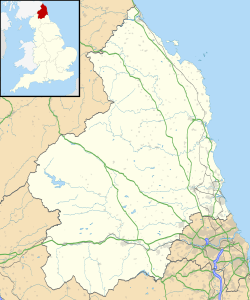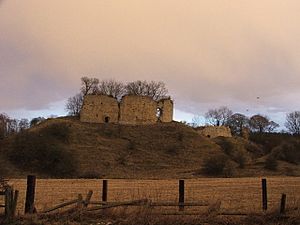Mitford Castle facts for kids
Quick facts for kids Mitford Castle |
|
|---|---|
| Northumberland, England, UK | |

Mitford Castle, 2005
|
|
|
Location in Northumberland
|
|
| Coordinates | 55°09′50″N 1°44′02″W / 55.164°N 1.734°W |
Mitford Castle is an old English castle. It was built around the late 1000s in Mitford, Northumberland. This castle is a very important historical site. It is protected by the government because of its age and special design.
The castle is a Norman 'motte and bailey' type. This means it had a big mound (the motte) with a tower on top. It also had a walled area below (the bailey). It sits on a small hill overlooking the River Wansbeck. The builders chose this spot because the natural hill could be shaped easily to make the motte.
Mitford Castle was the first main home for the Mitford family. After the castle was destroyed, the family used Mitford Old Manor House. Later, they built Mitford Hall in 1828. Mitford Hall is still there today, surrounded by a large park.
Contents
Who Owned Mitford Castle?
Before the Normans conquered England in 1066, a knight named Sir John de Mitford owned the land. His daughter, Sybilla, was married off by William the Conqueror to a Norman knight, Richard Bertram. This is how the Bertram family came to own the castle.
In the late 1000s, it was an earthwork fort belonging to the Bertram family. Records show it was a strong place in 1138.
Castle Seized by Kings
In 1215, King John's soldiers took control of the castle. Later, in 1264, the castle was owned by Roger Bertram. But it was taken from him and given to William de Valence, 1st Earl of Pembroke. He was King Henry III's half-brother.
In 1275, Alexander de Balliol held the castle. He was the brother of John Balliol, who later became King of Scotland.
The Rebellion and Destruction
Around the 1310s, there was a rebellion in Northumberland. During this time, Sir Gilbert de Middleton took Mitford Castle from the Valence family. In 1315, Sir Gilbert used the castle for kidnappings. He held important prisoners there, like the Bishop of Durham.
However, Sir Gilbert was later captured for treason by Ralph de Greystoke, 1st Baron Greystoke. Sir Gilbert was taken to the Tower of London and executed.
There are different ideas about how the castle was destroyed. Some think it burned down during Middleton's rebellion. Others believe the Scots destroyed it in May 1318. What we know for sure is that by 1323, the castle was "entirely destroyed and burnt."
The castle and its land were bought by the Bruce Shepherd family in 1993. This was from the Mitford family. In the 2000s, English Heritage gave money to help repair and save parts of the castle. Some of this work has been finished.
What Did Mitford Castle Look Like?
The castle ruins are made of well-cut, squared stones. The inner part of the castle, called the inner ward, was built in the early 1100s. It has a large rounded archway.
The inner ward also has a very unusual five-sided tower, called a keep. This keep dates from the early 1200s. It was built on the highest point of the castle. Each of its five sides is a different size. Inside, it was about 22 square feet (2 square meters).
The outer part of the castle, the outer ward, was built in the late 1100s. It has two basement rooms that might have been used as water tanks.
Other Castle Buildings
There was also a chapel built in the mid-1100s. Most of it was destroyed in the early 1800s. Only a sanctuary arch remains. In 1939, a cemetery was found north of the chapel. It had gravestones from the 1100s.
Parts of an east wall from the 1100s or 1200s still stand. This wall included a gate to a small walled area (a barmkin). It also had small rooms and a toilet (a garderobe). This east wall was the strongest part of the castle. The west wall also dates from the 1100s or 1200s.
The castle also had an inner courtyard. It was used as a garden and orchard. It measured about 340 feet (100 meters) by 340 feet (100 meters).



